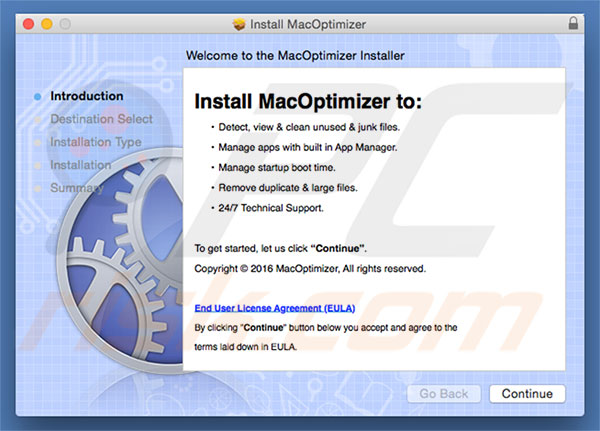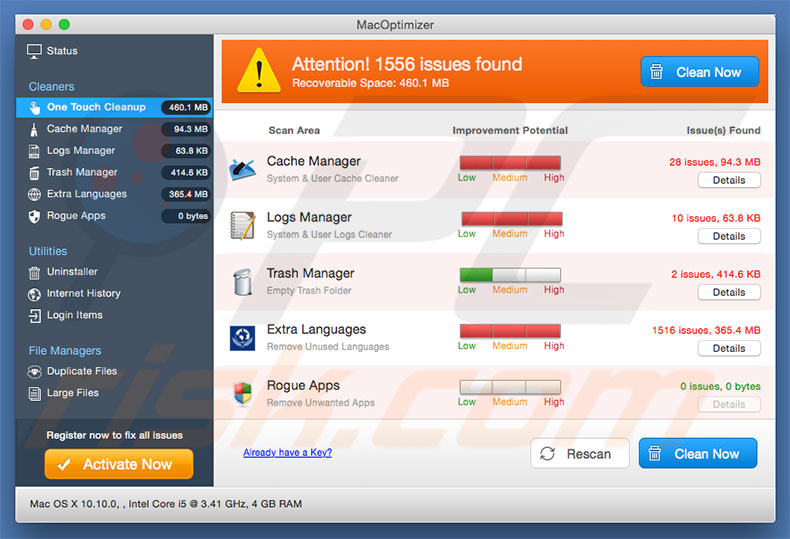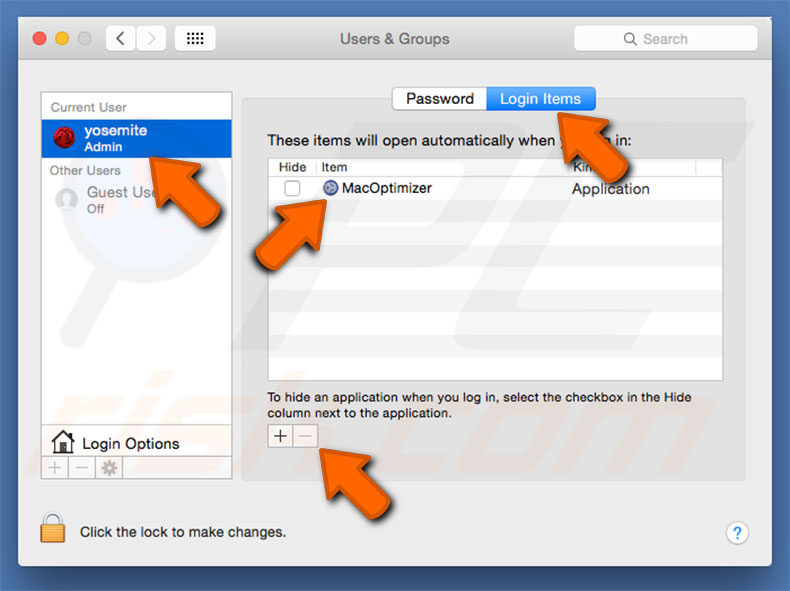MacOptimizer Unwanted Application (Mac)
Mac VirusAlso Known As: MacOptimizer potentially unwanted program
Get free scan and check if your device is infected.
Remove it nowTo use full-featured product, you have to purchase a license for Combo Cleaner. Seven days free trial available. Combo Cleaner is owned and operated by RCS LT, the parent company of PCRisk.com.
What is MacOptimizer?
MacOptimizer is a deceptive application identical to Advanced Mac Cleaner, Mac Mechanic, and a number of others.
By offering various system optimization-related features, MacOptimizer often tricks users into believing that it is legitimate and useful. In fact, this app is categorized as a potentially unwanted program (PUP). Research shows that, in most cases, MacOptimizer infiltrates systems without permission.

Following infiltration, MacOptimizer claims to scan the system and display potential errors. Users are encouraged to remove them immediately, however, since MacOptimizer's free version is apparently unable to do so, they are encouraged purchase the full version. Note that the entire list of errors is false - your system is likely to be perfectly safe and optimized.
Developers generate revenue by abusing users' trust. MacOptimizer is a useless application and you should never pay for the full version - you are advised to uninstall it immediately. As mentioned above, MacOptimizer usually infiltrates systems without users' consent. There is a high probability that it came together with a number of other PUPs.
Research shows that potentially unwanted programs typically do three things: 1) display intrusive advertisements ["Pay Per Click" - PPC - advertising model]; 2) modify web browser options [promoting dubious sites, most of which are fake search engines], and; 3) collect sensitive information [which is later sold to third parties]. These applications deliver no real value for regular users and should be uninstalled.
| Name | MacOptimizer potentially unwanted program |
| Threat Type | Mac malware, Mac virus |
| Symptoms | Your Mac became slower than normal, you see unwanted pop-up ads, you get redirected to shady websites. |
| Distribution methods | Deceptive pop-up ads, free software installers (bundling), fake flash player installers, torrent file downloads. |
| Damage | Internet browsing tracking (potential privacy issues), displaying of unwanted ads, redirects to shady websites, loss of private information. |
| Malware Removal (Windows) |
To eliminate possible malware infections, scan your computer with legitimate antivirus software. Our security researchers recommend using Combo Cleaner. Download Combo CleanerTo use full-featured product, you have to purchase a license for Combo Cleaner. 7 days free trial available. Combo Cleaner is owned and operated by RCS LT, the parent company of PCRisk.com. |
MacOptimizer shares many similarities with Mac Space Reviver, MyShopcoupon, LiveShoppers, and dozens of other potentially unwanted programs. As with MacOptimizer, these apps also offer certain "useful functions", however, claims to provide them are merely attempts to trick users to install.
In fact, all PUPs are designed only to generate revenue for the developers and typically deliver no real value for regular users. PUPs spread intrusive ads, cause unwanted redirects, gather various information, and promote in-app purchases.
How did MacOptimizer install on my computer?
MacOptimizer is free for anyone to download on its official website, however, as with most potentially unwanted programs, it often infiltrates systems without permission. The reasons for this are the careless behavior and poor knowledge of many users. Developers proliferate PUPs by "bundling" and intrusive advertising methods.
"Bundling" is essentially stealth installation of third party applications with regular software/apps. Developers do not disclose these installations properly - they hide "bundled apps within "Custom/Advanced" settings (or other sections) of the download/installation processes.
Furthermore, many users skip steps and click dubious - yet "tempting" - links/ads. This behavior often leads to inadvertent installation of potentially unwanted programs, such as MacOptimizer.
How to avoid installation of potentially unwanted applications?
The main reasons for computer infections are poor knowledge and careless behavior. The key to safety is caution. Therefore, pay close attention when browsing the Internet and downloading/installing software. Research shows that cyber criminals invest a great deal of time and effort into designing intrusive ads. Therefore, most look legitimate.
Once clicked, however, they redirect to gambling, adult dating, pornography, and other dubious sites. If you experience these redirects, immediately eliminate all dubious applications and browser plug-ins. Furthermore, select "Advanced/Custom" settings and closely analyze each step of the download/installation procedures.
Decline offers to download/install additional applications and cancel those already included. Note that criminals monetize unofficial downloaders/installers by promoting rogue apps ("bundling" method).
Therefore, you are advised to download your apps only from official/certified sources, using direct download links. We also strongly recommend that you use a legitimate anti-virus/anti-spyware suite.
Deceptive application installer promoting MacOptimizer adware:

Screenshot of potentially unwanted program MacOptimizer:

IMPORTANT NOTE! MacOptimizer adds itself to the list of applications that automatically run upon each user log in. Therefore, before commencing, perform these steps:
- Go to System Preferences -> Users & Groups.
- Click your account (also known as Current User).
- Click Login Items.
- Look for the "MacOptimizer" entry. Select it, and click the "-" button to remove it.

Instant automatic malware removal:
Manual threat removal might be a lengthy and complicated process that requires advanced IT skills. Combo Cleaner is a professional automatic malware removal tool that is recommended to get rid of malware. Download it by clicking the button below:
DOWNLOAD Combo CleanerBy downloading any software listed on this website you agree to our Privacy Policy and Terms of Use. To use full-featured product, you have to purchase a license for Combo Cleaner. 7 days free trial available. Combo Cleaner is owned and operated by RCS LT, the parent company of PCRisk.com.
Quick menu:
- What is MacOptimizer?
- STEP 1. Remove MacOptimizer related files and folders from OSX.
- STEP 2. Remove rogue extensions from Safari.
- STEP 3. Remove bogus add-ons from Google Chrome.
- STEP 4. Remove rogue plug-ins from Mozilla Firefox.
Video showing how to remove adware and browser hijackers from a Mac computer:
MacOptimizer PUP removal:
Remove potentially unwanted applications from the "Applications" folder:

Click the Finder icon. In the Finder window, select “Applications”. In the applications folder, look for “MacOptimizer” and other suspicious applications and drag them to the Trash. After removing the potentially unwanted application(s) that cause online ads, scan your Mac for any remaining unwanted components.
DOWNLOAD remover for malware infections
Combo Cleaner checks if your computer is infected with malware. To use full-featured product, you have to purchase a license for Combo Cleaner. 7 days free trial available. Combo Cleaner is owned and operated by RCS LT, the parent company of PCRisk.com.
Remove adware-related files and folders

Click the Finder icon, from the menu bar. Choose Go, and click Go to Folder...
 Check for adware generated files in the /Library/LaunchAgents/ folder:
Check for adware generated files in the /Library/LaunchAgents/ folder:

In the Go to Folder... bar, type: /Library/LaunchAgents/

In the "LaunchAgents" folder, look for any recently-added suspicious files and move them to the Trash. Examples of files generated by adware - "installmac.AppRemoval.plist", "myppes.download.plist", "mykotlerino.ltvbit.plist", "kuklorest.update.plist", etc. Adware commonly installs several files with the exact same string.
 Check for adware generated files in the ~/Library/Application Support/ folder:
Check for adware generated files in the ~/Library/Application Support/ folder:

In the Go to Folder... bar, type: ~/Library/Application Support/

In the "Application Support" folder, look for any recently-added suspicious folders. For example, "MplayerX" or "NicePlayer", and move these folders to the Trash.
 Check for adware generated files in the ~/Library/LaunchAgents/ folder:
Check for adware generated files in the ~/Library/LaunchAgents/ folder:

In the Go to Folder... bar, type: ~/Library/LaunchAgents/

In the "LaunchAgents" folder, look for any recently-added suspicious files and move them to the Trash. Examples of files generated by adware - "installmac.AppRemoval.plist", "myppes.download.plist", "mykotlerino.ltvbit.plist", "kuklorest.update.plist", etc. Adware commonly installs several files with the exact same string.
 Check for adware generated files in the /Library/LaunchDaemons/ folder:
Check for adware generated files in the /Library/LaunchDaemons/ folder:

In the "Go to Folder..." bar, type: /Library/LaunchDaemons/

In the "LaunchDaemons" folder, look for recently-added suspicious files. For example "com.aoudad.net-preferences.plist", "com.myppes.net-preferences.plist", "com.kuklorest.net-preferences.plist", "com.avickUpd.plist", etc., and move them to the Trash.
 Scan your Mac with Combo Cleaner:
Scan your Mac with Combo Cleaner:
If you have followed all the steps correctly, your Mac should be clean of infections. To ensure your system is not infected, run a scan with Combo Cleaner Antivirus. Download it HERE. After downloading the file, double click combocleaner.dmg installer. In the opened window, drag and drop the Combo Cleaner icon on top of the Applications icon. Now open your launchpad and click on the Combo Cleaner icon. Wait until Combo Cleaner updates its virus definition database and click the "Start Combo Scan" button.

Combo Cleaner will scan your Mac for malware infections. If the antivirus scan displays "no threats found" - this means that you can continue with the removal guide; otherwise, it's recommended to remove any found infections before continuing.

After removing files and folders generated by the adware, continue to remove rogue extensions from your Internet browsers.
Remove malicious extensions from Internet browsers
 Remove malicious Safari extensions:
Remove malicious Safari extensions:

Open the Safari browser, from the menu bar, select "Safari" and click "Preferences...".

In the preferences window, select "Extensions" and look for any recently-installed suspicious extensions. When located, click the "Uninstall" button next to it/them. Note that you can safely uninstall all extensions from your Safari browser - none are crucial for regular browser operation.
- If you continue to have problems with browser redirects and unwanted advertisements - Reset Safari.
 Remove malicious extensions from Google Chrome:
Remove malicious extensions from Google Chrome:

Click the Chrome menu icon ![]() (at the top right corner of Google Chrome), select "More Tools" and click "Extensions". Locate all recently-installed suspicious extensions, select these entries and click "Remove".
(at the top right corner of Google Chrome), select "More Tools" and click "Extensions". Locate all recently-installed suspicious extensions, select these entries and click "Remove".

- If you continue to have problems with browser redirects and unwanted advertisements - Reset Google Chrome.
 Remove malicious extensions from Mozilla Firefox:
Remove malicious extensions from Mozilla Firefox:

Click the Firefox menu ![]() (at the top right corner of the main window) and select "Add-ons and themes". Click "Extensions", in the opened window locate all recently-installed suspicious extensions, click on the three dots and then click "Remove".
(at the top right corner of the main window) and select "Add-ons and themes". Click "Extensions", in the opened window locate all recently-installed suspicious extensions, click on the three dots and then click "Remove".

- If you continue to have problems with browser redirects and unwanted advertisements - Reset Mozilla Firefox.
Share:

Tomas Meskauskas
Expert security researcher, professional malware analyst
I am passionate about computer security and technology. I have an experience of over 10 years working in various companies related to computer technical issue solving and Internet security. I have been working as an author and editor for pcrisk.com since 2010. Follow me on Twitter and LinkedIn to stay informed about the latest online security threats.
PCrisk security portal is brought by a company RCS LT.
Joined forces of security researchers help educate computer users about the latest online security threats. More information about the company RCS LT.
Our malware removal guides are free. However, if you want to support us you can send us a donation.
DonatePCrisk security portal is brought by a company RCS LT.
Joined forces of security researchers help educate computer users about the latest online security threats. More information about the company RCS LT.
Our malware removal guides are free. However, if you want to support us you can send us a donation.
Donate
▼ Show Discussion